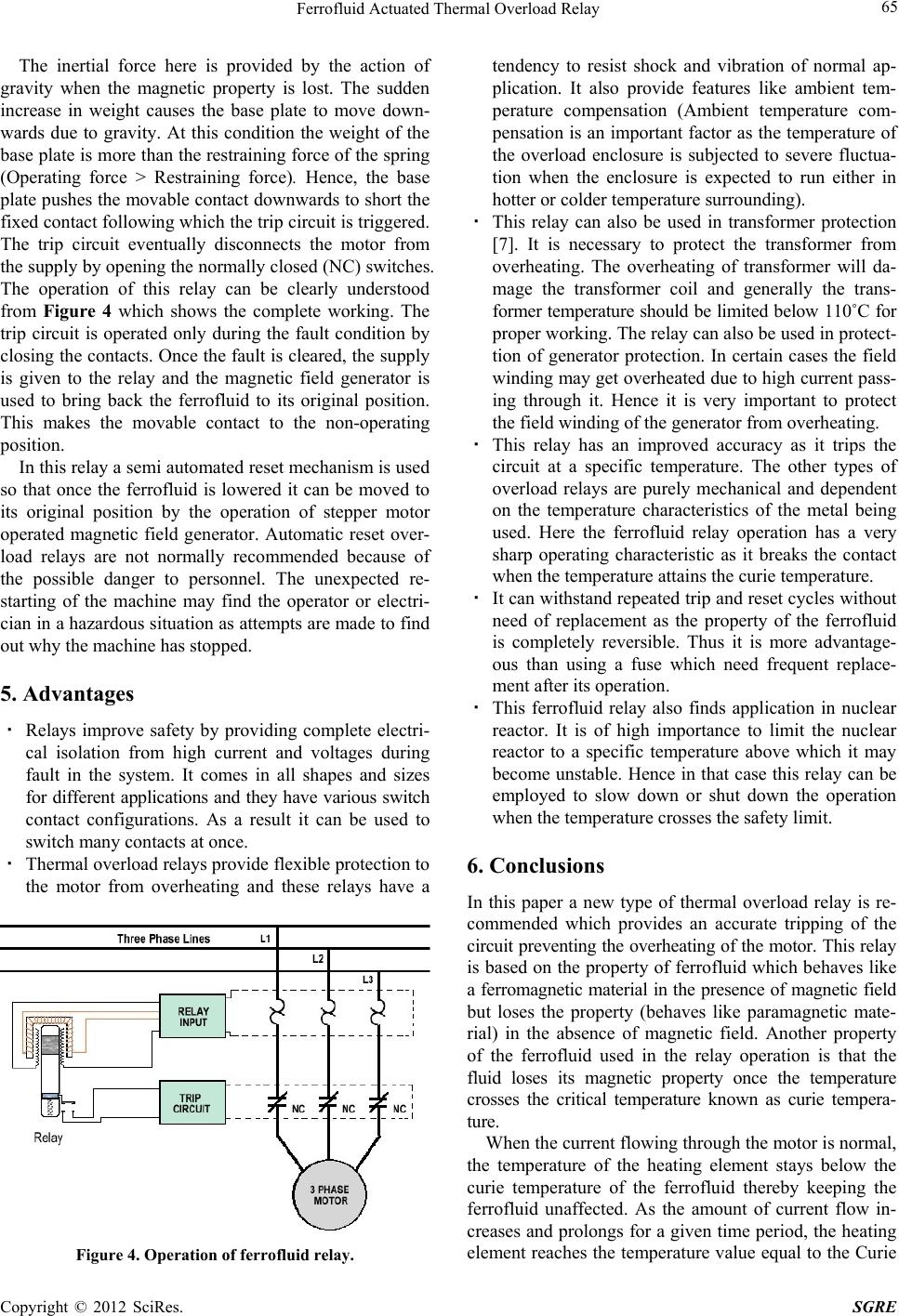
Ferrofluid Actuated Thermal Overload Relay 65
The inertial force here is provided by the action of
gravity when the magnetic property is lost. The sudden
increase in weight causes the base plate to move down-
wards due to gravity. At this condition the weight of the
base plate is more than the restraining force of the spring
(Operating force > Restraining force). Hence, the base
plate pushes the movable contact downwards to short the
fixed contact following which the trip circuit is triggered.
The trip circuit eventually disconnects the motor from
the supply by opening the normally closed (NC) switches.
The operation of this relay can be clearly understood
from Figure 4 which shows the complete working. The
trip circuit is operated only during the fault condition by
closing the contacts. Once the fault is cleared, the supp ly
is given to the relay and the magnetic field generator is
used to bring back the ferrofluid to its original position.
This makes the movable contact to the non-operating
position.
In this relay a semi automated reset mechanism is used
so that once the ferrofluid is lowered it can be moved to
its original position by the operation of stepper motor
operated magnetic field generator. Automatic reset over-
load relays are not normally recommended because of
the possible danger to personnel. The unexpected re-
starting of the machine may find the operator or electri-
cian in a hazardous situation as attempts are made to find
out why the machine has stopped.
5. Advantages
· Relays improve safety by providing complete electri-
cal isolation from high current and voltages during
fault in the system. It comes in all shapes and sizes
for different applications and they have various switch
contact configurations. As a result it can be used to
switch many contacts at once.
· Thermal overload relays provide flexible protection to
the motor from overheating and these relays have a
Figure 4. Operation of ferrofluid relay.
tendency to resist shock and vibration of normal ap-
plication. It also provide features like ambient tem-
perature compensation (Ambient temperature com-
pensation is an important factor as the temperature of
the overload enclosure is subjected to severe fluctua-
tion when the enclosure is expected to run either in
hotter or colder temperature surrounding).
· This relay can also be used in transformer protection
[7]. It is necessary to protect the transformer from
overheating. The overheating of transformer will da-
mage the transformer coil and generally the trans-
former temperature should be limited below 110˚C for
proper working. The relay can also be used in protect-
tion of generator protection. In certain cases the field
winding may get overheated due to high current pass-
ing through it. Hence it is very important to protect
the field winding of the generator from overheating.
· This relay has an improved accuracy as it trips the
circuit at a specific temperature. The other types of
overload relays are purely mechanical and dependent
on the temperature characteristics of the metal being
used. Here the ferrofluid relay operation has a very
sharp operating characteristic as it breaks the contact
when the temperature attains the curie temperature.
· It can withstand repeated trip and reset cycles without
need of replacement as the property of the ferrofluid
is completely reversible. Thus it is more advantage-
ous than using a fuse which need frequent replace-
ment after its operation.
· This ferrofluid relay also finds application in nuclear
reactor. It is of high importance to limit the nuclear
reactor to a specific temperature above which it may
become unstable. Hence in that case this relay can be
employed to slow down or shut down the operation
when the temperature crosses the safety limit.
6. Conclusions
In this paper a new type of thermal overload relay is re-
commended which provides an accurate tripping of the
circuit preventing the overheating of the motor. This relay
is based on the property of ferrofluid which behaves like
a ferromagnetic material in the presence of magnetic field
but loses the property (behaves like paramagnetic mate-
rial) in the absence of magnetic field. Another property
of the ferrofluid used in the relay operation is that the
fluid loses its magnetic property once the temperature
crosses the critical temperature known as curie tempera-
ture.
When the current flowing thro ugh the motor is nor mal,
the temperature of the heating element stays below the
curie temperature of the ferrofluid thereby keeping the
ferrofluid unaffected. As the amount of current flow in-
creases and prolongs for a given time period, the heating
element reaches the temperature value equal to the Curie
Copyright © 2012 SciRes. SGRE